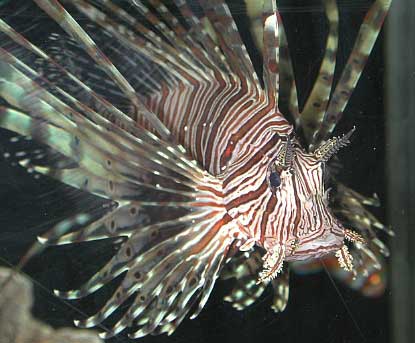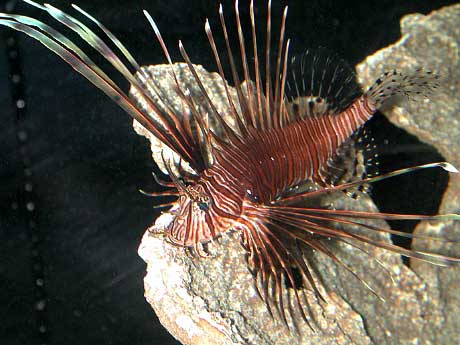In the mid 1990s, the species P. volitans and P. miles were unintentionally introduced into the Atlantic Ocean and have become an invasive species along the East Coast of the United States.
Lionfish are known for their venomous fin rays, a feature that is uncommon among marine fish in the East Coast coral reefs. The potency of their venom makes them excellent predators and dangerous to fishermen and divers. Pterois venom produced negative inotropic and chronotropic effects when tested in both frog and clam hearts and has a depressing effect on rabbit blood pressure. These results are thought to be due to nitric oxide release. In humans, Pterois venom can cause systemic effects such as vomiting, fever and sweating and has been lethal in a few cases.
According to a study that involved the dissection of over 1,400 lionfish stomachs from Bahamian to North Carolinian waters, Pterois prey mostly on small fish, invertebrates and mollusks in large amounts, with some specimens' stomachs containing up to six different species of prey. The amount of prey in lionfish stomachs over the course of the day suggest that lionfish feed most actively from 7:00-11:00 A.M., with decreased feeding throughout the afternoon. Lionfish are skilled hunters, using specialized bilateral swim bladder muscles to provide exquisite control of location in the water column, allowing the fish to alter its center of gravity to better attack prey. The lionfish then spreads its large pectoral fins and swallows its prey in a singe motion. Tiger grouper (Mycteroperca tigris) have been shown to occasionally prey on Pterois, but these findings have been few and far between.
Pterois can live from five to fifteen years and have complex courtship and mating behaviors. Females release two mucus-filled egg clusters frequently, which can contain as many as fifteen thousand eggs. Studies on Pterois reproductive habits are have increased significantly in the past decade.
The lionfish is a predator native to the Indo-Pacific. It aggressively preys on small fish and invertebrates. They can be found around the seaward edge of reefs and coral, in lagoons, and on rocky surfaces to fifty meters. They show a preference for turbid inshore areas and in harbors. Lionfish have a generally hostile attitude and are territorial towards other reef fish. Many universities in the Indo-Pacific have documented reports of Pterois aggression towards divers and researchers.
Two of the fifteen species of Pterois, P. volitans and P. miles, have established themselves as significant invasive species off the East Coast of the United States and in the Caribbean. About 93% of the invasive population is P. volitans, also known as the Red Lionfish.
The red lionfish is found off the East Coast of the United States and the Caribbean Sea, and was likely first introduced off the Florida coast in the early to mid-1990s. It has been speculated that this introduction may have been caused when Hurricane Andrew destroyed an aquarium in southern Florida, It is also believed that six lionfish were accidentally released in Biscayne Bay, Florida after Hurricane Andrew in 1992. However, a more recent report states NOAA ecologist James Morris Jr. has discovered that a lionfish was discovered off the coast of south Florida prior to Hurricane Andrew in 1985. It is also believed that the lionfish were purposefully discarded by unsatisfied aquarium enthusiasts. The first documented capture of lionfish in the Atlantic occurred in Dania Beach, Florida. In 2001, NOAA documented multiple sightings of lionfish off the coast of Florida, Georgia, South Carolina, North Carolina, and Bermuda, and were first detected in the Bahamas in 2004. Pterois volitans and Pterois miles are native to sub-tropical and tropical regions from southern Japan and southern Korea to the east coast of Australia, Indonesia, Micronesia, French Polynesia and in the South Pacific Ocean. Adult lionfish specimens are now found along the United States East Coast from Cape Hatteras, North Carolina, to Florida, and in Bermuda, the Bahamas, and throughout the Caribbean, including the Turks and Caicos, Haiti, Cuba, Dominican Republic, Aruba, Curacao, Puerto Rico, St. Croix, Belize, Honduras and Mexico. Population densities continue to increase in the invaded areas, resulting in a population boom of up to 700% in some areas between 2004 and 2008. Population densities have reached levels that are orders of magnitude greater than their native ranges. Pterois are known for devouring many other aquarium fishes. Pterois are unusual in that they are among the few fish species to successfully establish populations in open marine systems.
Lionfish are known for their venomous fin rays, a feature that is uncommon among marine fish in the East Coast coral reefs. The potency of their venom makes them excellent predators and dangerous to fishermen and divers. Pterois venom produced negative inotropic and chronotropic effects when tested in both frog and clam hearts and has a depressing effect on rabbit blood pressure. These results are thought to be due to nitric oxide release. In humans, Pterois venom can cause systemic effects such as vomiting, fever and sweating and has been lethal in a few cases.
According to a study that involved the dissection of over 1,400 lionfish stomachs from Bahamian to North Carolinian waters, Pterois prey mostly on small fish, invertebrates and mollusks in large amounts, with some specimens' stomachs containing up to six different species of prey. The amount of prey in lionfish stomachs over the course of the day suggest that lionfish feed most actively from 7:00-11:00 A.M., with decreased feeding throughout the afternoon. Lionfish are skilled hunters, using specialized bilateral swim bladder muscles to provide exquisite control of location in the water column, allowing the fish to alter its center of gravity to better attack prey. The lionfish then spreads its large pectoral fins and swallows its prey in a singe motion. Tiger grouper (Mycteroperca tigris) have been shown to occasionally prey on Pterois, but these findings have been few and far between.
 Photo: Lionfish swimming among |  This lionfish will reach a |  Lionfish Decimating Tropical |  lion fish animal lionfish |  Atlantic Lionfish? |
 Image: Lion fish | lionfish |  Lionfish |  Also, Volitans lionfish have |  red lionfish pterois volitans |
Two of the fifteen species of Pterois, P. volitans and P. miles, have established themselves as significant invasive species off the East Coast of the United States and in the Caribbean. About 93% of the invasive population is P. volitans, also known as the Red Lionfish.
 Red Volitans Lionfish Indo |  lion fish animal lionfish |  Volitan Colored Lionfish |  Lion-fish wins a prize. | Atlantic Lionfish? |
 Dwarf Lionfish | Lionfish, now found in high |  The lionfish is considered as |  two lionfish were |  PADI Lion Fish containment |
Tidak ada komentar:
Posting Komentar